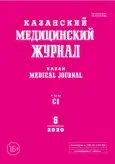Comparative characteristics of computed tomography and radiography in the diagnosis of blunt chest trauma
- Authors: Gasimzade GS.1
-
Affiliations:
- Azerbaijan State Advanced Training Institute for Doctors named after A. Aliyev
- Issue: Vol 101, No 6 (2020)
- Pages: 926-929
- Section: Clinical experiences
- URL: https://ogarev-online.ru/kazanmedj/article/view/25804
- DOI: https://doi.org/10.17816/KMJ2020-926
- ID: 25804
Cite item
Abstract
Aim. To conduct a comparative analysis of the effectiveness of X-ray diagnostics and computed tomography in detecting injuries in patients with blunt chest trauma.
Methods. We examined 68 patients with chest injuries (men and women) and an average age of 34.6±7 years (between 18 and 65 years). The causes of injury were: road accidents — 37 (54.4%), falls from a height — 21 (30.8%), blunt blow to the chest — 10 (14.8%). The results of X-ray and computed tomography examination of patients were compared.
Results. X-ray examination revealed a chest bone fracture in 24 (35.3%) patients, while computed tomography revealed a bone fracture in 32 (47.1%) cases (χ2=1.943; p=0.163). This allows us to state that the results of compu¬ted tomography scans are more accurate in the diagnosis of chest fractures. computed tomography scan revealed chest injuries — pneumothorax and hemothorax, in 56 (82.4%) cases, while X-ray examination in 37 (54.4%) ¬cases (χ2=12.277; p <0.001). Thus, the results of the study showed that computed tomography is a more informative ¬method of diagnosis compared to radiography, since computed tomography revealed 11.8% more cases of chest bones fractures, and 28.0% more cases of chest cavity damage with blunt trauma.
Conclusion. Our study allows us to recommend computed tomography of the chest in blunt trauma as the initial preferred diagnostic radiology.
Full Text
##article.viewOnOriginalSite##About the authors
G Sh Gasimzade
Azerbaijan State Advanced Training Institute for Doctors named after A. Aliyev
Author for correspondence.
Email: dr.gasimzade@mail.ru
Azerbaijan, Baku, Azerbaijan
References
- Shendrik A.Yu. Multislice computed tomography in the diagnostics of fractures in costo-vertebral zone of blunt thoracic trauma. Radiologiya — praktika. 2010; (5): 25–29. (In Russ.)
- Awais M., Salam B., Nadeem N. et al. Diagnostic accuracy of computed tomography scout film and chest X-ray for detection of rib fractures in patients with chest trauma: A crossectional study. Cureus. 2019; 11 (1): e3875. doi: 10.7759/cureus.3875.
- Al-Koudmani I., Darwish B., Al-Kateb K., Taifour Y. Chest trauma experience over eleven-year period at Al-Mouassat university teaching hospital-Damascus: a retrospective review of 888 cases. J. Cardiothorac. Surg. 2012; 7: 35. doi: 10.1186/1749-8090-7-35.
- Morley E.J., Johnson S., Leibner E., Shahid J. Emergency department evaluation and management of blunt chest and lung trauma (Trauma CME). Emerg. Med. Pract. 2016; 18: 1–20. PMID: 27177417.
- Akhmedov D., Davlatov B.H., Nurov A.P., Safoev H.A. Influence of severe blunt chest trauma on gas exchange. Vestnik Avitsenny. 2017; 19 (2): 147–150. (In Russ.) doi: 10.25005/2074-0581-2017-19-2-147-150.
- Yazkan R., Ergene G., Tulay C.M. et al. Comparison of chest computed tomography and chest X-ray in the diagnosis of rib fractures in patients with blunt chest trauma. J. Acad. Emer. Med. 2012; 11: 171–175. doi: 10.5152/jaem.2012.025.
- Rodriguez R., Langdorf M., Nishijima D. et al. Derivation and validation of two decision instruments for selective chest CT in blunt trauma: a multicenter prospective observational study (NEXUS Chest CT). PLoS Med. 2015; 12 (10): e1001883. doi: 10.1371/journal.pmed.1001883.
- Traub M., Stevenson M., McEvoy S. et al. The use of chest computed tomography versus chest X-ray in patients with major blunt trauma. Injury. 2007; 38: 43–47. doi: 10.1016/j.injury.2006.07.006.
- Dorovskyh G.N. Cranial-thoracic trauma radiologic evaluation. Bulletin of Siberian medicine. 2012; 11 (5): 108–117. (In Russ.) doi: 10.20538/1682-0363-2012-5-108-117.
- Mahambetchin M.M. Zakrytaya travma grudnoy kletki: problemy diagnostiki. (Closed chest trauma: problems of diagnosis.) M.: Logosfera. 2016; 232 р. (In Russ.)
- Harrison M. Traumatic pneumothorax: a review of current practice. Brit. J. Hospital Med. 2014; 75 (3): 132–135. doi: 10.12968/hmed.2014.75.3.132.
- Kea Bory, Gamarallage R., et al. What is the clinical significance of chest CT when the chest X-ray result is normal in patients with blunt trauma? Am. J. Emergency Med. 2013; 31 (8): 1268–1273. doi: 10.1016/j.ajem.2013.04.021.
- El Wakeel M.A., Abdullah S.M., Abd E., Khalek R.S. Role of computed tomography in detection of complications of blunt chest trauma. Menoufia. Med. 2015; 28: 483–487. doi: 10.4103/1110-2098.163906.
- O'Connor J.V., Byrne C., Scalea T.M. et al. Vascular injuries after blunt chest trauma: diagnosis and management. Scand. J. Trauma Resusc. Emerg. Med. 2009; 17: 42. DOI: 10,1186/1757-7241-17-42.
- Lema K., Chalya P.L., Mabula J.B., Mahalu W. Pattern and outcome of chest injuries at Bugando Medical Centre in Northwestern Tanzania. J. Cardiothorac. Surg. 2011; 6: 7. doi: 10.1186/1749-8090-6-7.
- Mirka H., Ferda J., Baxa J. Multidetector computed tomography of chest trauma: indications, technique and interpretation. Insights Imaging. 2012; 3: 433–449. doi: 10.1007/s13244-012-0187.
Supplementary files








